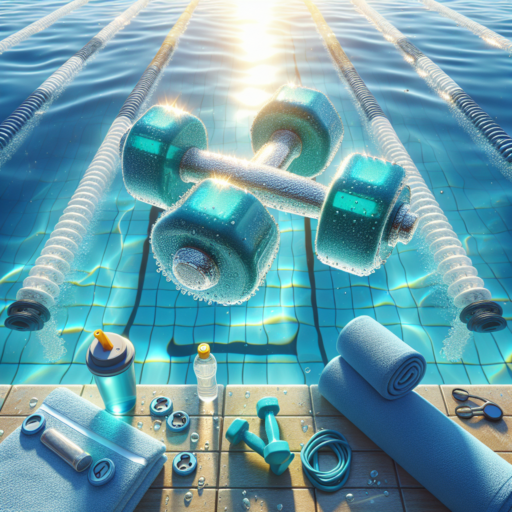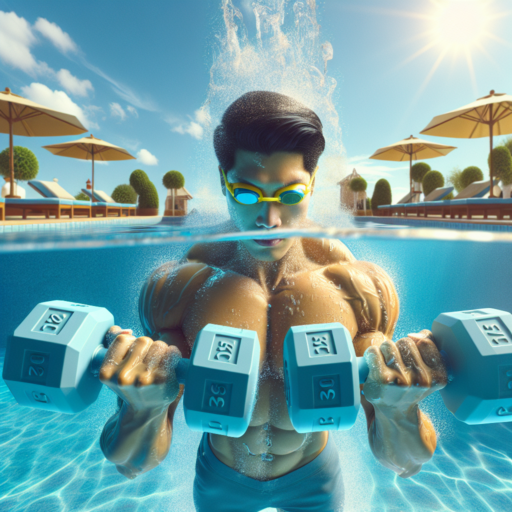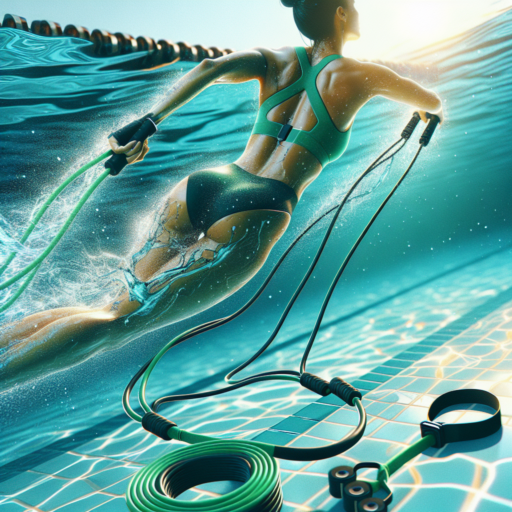What Are Swim Dumbbells and How Can They Improve Your Workout?
Swim dumbbells, also known as aqua dumbbells or water weights, are lightweight, buoyant fitness tools designed for use in water. Unlike traditional dumbbells, which are constructed from metal or other heavy materials, swim dumbbells are made of foam or other materials that provide resistance in a pool or water environment. This unique feature allows swimmers and aquatic fitness enthusiasts to perform resistance training exercises while submerged, leveraging the natural resistance of water to enhance their workout regime.
Benefits of Using Swim Dumbbells
- Increased Resistance: Water is denser than air, so moving swim dumbbells through water requires more effort than performing similar movements in air. This increased resistance helps in building muscle strength and endurance.
- Low-Impact Training: The buoyancy of water reduces the strain on joints and muscles, making swim dumbbells an excellent option for low-impact workouts. This is particularly beneficial for individuals with joint concerns or those recovering from injury.
- Improves Cardiovascular Health: Using swim dumbbells in aerobic exercises can elevate heart rate and improve cardiovascular health, similar to traditional aerobic exercises but in a cooler, pool environment.
Integrating swim dumbbells into aquatic workouts can significantly improve the effectiveness of your workout by challenging your body in new ways. As you push and pull the dumbbells through the water, you engage multiple muscle groups simultaneously, leading to a comprehensive, full-body workout. Additionally, the resistance offered by the water can be adjusted simply by altering the speed and intensity of your movements, making swim dumbbells a versatile tool for fitness enthusiasts of all levels.
The Benefits of Using Swim Dumbbells for Aquatic Exercise
Integrating swim dumbbells into aquatic exercise routines offers a range of benefits designed to enhance physical health and fitness. These versatile tools provide a unique way to increase resistance in water, leading to improved muscle strength. Engaging in exercises that involve swim dumbbells activates various muscle groups, from arms and shoulders to the core and legs, ensuring a comprehensive workout.
The buoyant nature of swim dumbbells adds a unique element to water-based workouts. Unlike traditional weights, these dumbbells are designed to be used underwater, offering resistance that is significantly different from air-based exercises. This resistance is key to building muscular endurance and increasing overall body strength. Moreover, the adaptable intensity level of swim dumbbells caters to both beginners and seasoned athletes, making aquatic exercise accessible and beneficial for a wide audience.
Another significant advantage of using swim dumbbells for aquatic exercise is the reduction of impact on joints. Water provides a natural cushion that minimizes stress on the body, making swim dumbbells an excellent option for those who are interested in maintaining a fitness regimen that is gentle on the knees, hips, and back. This aspect is particularly beneficial for individuals with arthritis or for those who are recovering from injury, highlighting the therapeutic potential of aquatic exercise with swim dumbbells.
No se han encontrado productos.
Top Exercises to Perform with Swim Dumbbells for Maximum Efficiency
Integrating swim dumbbells into your aquatic workouts can significantly enhance muscle strength and cardiovascular health. These specialized fitness tools offer resistance in the water, providing a unique challenge to your exercise routine. Below, we delve into some of the top exercises that leverage swim dumbbells for maximum efficiency. These workouts focus on core strengthening, improving endurance, and enhancing overall body tone.
Aquatic Bicep Curls
One of the most effective exercises to begin with is the aquatic bicep curl. Position yourself in chest-deep water, holding the swim dumbbells with your palms facing up. Keep your elbows close to your torso and perform bicep curls by bending your arms at the elbows. This movement targets the biceps intensely, engaging your core for stability, making it a stellar choice for upper body strengthening.
Water Walking with Dumbbells
Water walking with swim dumbbells is another excellent exercise for promoting cardiovascular health while simultaneously working your arms and shoulders. Start by standing in waist-high water, holding the dumbbells at your sides. Walk forward for a set distance, then reverse direction, ensuring constant engagement of your arm muscles against the water’s resistance. This exercise not only boosts heart health but also aids in enhancing balance and coordination.
Shoulder Flies in the Pool
Shoulder flies are perfect for targeting the deltoid muscles in the shoulders. In a standing position with water up to your shoulders, hold the swim dumbbells out in front of you at chest level. Keeping a slight bend in your elbows, open your arms wide, then bring them back together. This exercise challenges your shoulder muscles, offering a broad range of motion that contributes significantly to upper body strength and flexibility.
Choosing the Right Swim Dumbbells for Your Fitness Level
Finding the perfect swim dumbbells for your workout routine can significantly enhance your aquatic exercises, but the process requires careful consideration. These tools come in various sizes, weights, and resistances, tailored to different fitness levels and goals. Whether you’re a beginner looking to add a low-impact routine to your workout or an experienced athlete aiming to boost endurance and strength, the right choice will help you maximize your water workouts.
For starters, understanding the materials used in swim dumbbells is crucial. Most are made from EVA foam, which provides excellent buoyancy and resistance in water – key factors in ensuring your workouts are both effective and safe. As you evaluate your options, consider the buoyancy level each model offers; this will directly influence the intensity of your workouts. High-buoyancy dumbbells are ideal for beginners, offering support and a moderate level of resistance. In contrast, models with less buoyancy present a greater challenge, suitable for those with a higher fitness level.
Another essential consideration is the size and grip of the dumbbells. Ergonomically designed grips can prevent hand fatigue and enhance your overall workout experience, allowing you to focus on your form and technique. Sizes vary significantly; larger dumbbells will increase resistance in water, making your muscles work harder. Thus, it’s important to select a size that complements your strength capabilities and fitness goals. If you’re new to aquatic exercises, starting with smaller, lighter dumbbells and gradually advancing as your strength and confidence grow is advisable.
Integrating Swim Dumbbells into Your Regular Swimming Routine
Integrating swim dumbbells into your regular swimming routine can be a game-changer for those looking to enhance their aquatic workouts. These tools are designed to increase resistance in the water, which can help in building muscle strength and endurance. The unique aspect of using swim dumbbells lies in their ability to provide a low-impact, yet highly effective resistance training method, making them perfect for swimmers of all levels.
One of the key benefits of incorporating swim dumbbells into your workout regime is the versatility they bring to your pool sessions. Whether you’re focusing on upper body strength, core stability, or overall endurance, swim dumbbells can be used in a variety of exercises to target different muscle groups. This versatility not only keeps your workouts interesting and challenging but also ensures a holistic approach to fitness, improving your swimming technique and performance.
Beginners looking to integrate swim dumbbells into their routines should start with lighter weights and gradually increase as their strength and confidence grow. It’s crucial to focus on maintaining proper form to maximize the benefits and avoid injury. With consistent practice, swimmers can notice improvements not only in their physical strength but also in their swimming speed and efficiency, thanks to the added resistance and training intensity that swim dumbbells provide.
Swim Dumbbells Vs. Traditional Dumbbells: Understanding the Difference
When stepping into the world of fitness, understanding the tools that can help you achieve your goals is crucial. Among these, swim dumbbells and traditional dumbbells stand out, each serving unique purposes and offering distinct benefits. Dive into the differences between these deux types of equipment to enhance your workout routine effectively.
Firstly, the principal distinction lies in their design and intended use. Swim dumbbells are constructed from lighter materials like foam and are used in water to create resistance. They are instrumental in aquatic exercises, aiding in improving cardiovascular health and muscle tone without putting stress on joints. On the other hand, traditional dumbbells are made of heavier materials like cast iron or steel and are primarily used for resistance training on land, focusing on muscle building and strength enhancement.
Key Features and Benefits
- Swim Dumbbells: Perfect for aquatic workouts, offering resistance that enhances muscle tone and cardiovascular fitness while being easy on the joints.
- Traditional Dumbbells: Ideal for building muscle strength and size, with the versatility to target almost every major muscle group through a variety of exercises.
Understanding the core differences between swim dumbbells and traditional dumbbells not only broadens your fitness tools knowledge but also opens up a wider array of exercises to incorporate into your routine. Whether you’re rehabilitating an injury with gentle water resistance or aiming to bulk up with some heavy lifting, choosing the right type of dumbbell is key to achieving your fitness objectives.
A Buyer’s Guide to the Best Swim Dumbbells on the Market in 2023
Choosing the best swim dumbbells in 2023 can significantly enhance your water workouts, offering both resistance and buoyancy to challenge your muscles differently than traditional weights. Whether you’re a seasoned swimmer aiming to intensify your training or someone looking to spice up aquatic exercises, understanding the features that distinguish the best options is crucial. This guide will navigate the key factors to consider when selecting swim dumbbells that align with your fitness goals and preferences.
Material Quality and Durability
The construction material of swim dumbbells plays an essential role in their effectiveness and longevity. High-quality foam or plastic resistant to chlorine and saltwater ensures that your investment withstands the test of time and exposure. Moreover, the material’s texture and grip are important for comfort and safety during your workouts.
Resistance Levels
Swim dumbbells come in various resistance levels, accommodating everyone from beginners to seasoned athletes. Choosing a set that matches your current fitness level yet allows for progression is key to a rewarding aquatic exercise regimen. It’s beneficial to look for adjustable or various resistance options to diversify your workouts and continuously challenge your muscles as you grow stronger.
In summary, the best swim dumbbell for you in 2023 should offer a balance between durability, comfort, and adjustability in resistance. Keeping these factors in mind will help you navigate the vast market and find a pair that suits your fitness journey in the pool perfectly.
How to Safely Use Swim Dumbbells During Your Water Workouts
Integrating swim dumbbells into your aquatic exercises can significantly enhance your water workouts by adding resistance. This additional resistance helps in building muscle strength and endurance. However, to reap these benefits without risking injury, it’s imperative to use swim dumbbells safely. By adhering to proper techniques and safety measures, you can ensure a rewarding and injury-free workout experience.
Choosing the Right Swim Dumbbells
Before diving into your water workout, selecting the appropriate swim dumbbells is crucial. Beginners should start with lighter weights and gradually increase the resistance as their strength and confidence grow. It’s important to choose dumbbells made of buoyant materials designed specifically for aquatic exercises. This ensures they provide the right amount of resistance while also being easy to handle underwater.
Proper Technique is Key
Maintaining proper technique is essential when exercising with swim dumbbells. Keep your movements smooth and controlled to avoid strain on your joints and muscles. It’s advisable to warm up before your session and start with exercises that match your fitness level. Incorporating a variety of movements can also prevent muscle imbalances and keep your workouts interesting. Remember, the focus is on quality over quantity to maximize the benefits of your water workout while ensuring safety.
Frequently Asked Questions About Swim Dumbbells
Swim dumbbells, an essential tool for aquatic fitness enthusiasts, often raise several questions among both beginners and seasoned swimmers. These questions not only reflect the curiosity about incorporating them into workouts but also pinpoint concerns regarding their effective use and benefits.
What Are Swim Dumbbells Made Of?
Commonly, swim dumbbells are crafted from materials that are inherently buoyant, allowing them to provide resistance while being lightweight enough for maneuverability in water. Materials such as EVA foam are popular due to their durability, resistance to chlorine, and the comfort they provide during exercises. The composition of these dumbbells is crucial for ensuring they last long and retain their buoyancy and shape.
How Do Swim Dumbbells Enhance My Workout?
Integrating swim dumbbells into aquatic exercises significantly amplifies the workout’s intensity. The resistance they offer not only aids in building muscle strength but also contributes to enhancing cardiovascular health. They are versatile tools that can be used for a wide range of exercises targeting different muscle groups, offering a full-body workout that improves flexibility, endurance, and overall fitness.
Can Beginners Use Swim Dumbbells?
Absolutely, beginners can and should utilize swim dumbbells as part of their aquatic exercise regimen. However, it is advisable to start with lighter weights and gradually increase the resistance as one becomes more comfortable and their strength improves. Starting with basic exercises and focusing on proper form can help in preventing injuries and maximizing the benefits of their workouts.
Real User Reviews: The Impact of Swim Dumbbells on Water Fitness
In the quest for innovative and effective fitness routines, water fitness has surged in popularity, and with it, the use of swim dumbbells. These specialized tools have transformed aquatic workouts, enhancing both resistance and enjoyment. Through real user reviews, we’ve gleaned the profound impact swim dumbbells have on water fitness routines, offering a lens into their versatile benefits and practical application in water-based exercises.
Users often highlight the immediate difference swim dumbbells make in their workouts. Unlike traditional gym routines, incorporating these aquatic tools introduces a unique form of resistance. According to enthusiasts, swim dumbbells are excellent for building upper body strength without the harsh impact on joints often associated with weightlifting. This advantage is particularly beneficial for those with mobility issues or those recovering from injuries, as noted in several user testimonials. The buoyancy of these dumbbells challenges muscles in new ways, contributing to enhanced muscle tone and endurance over time.
Furthermore, reviews frequently point out the adaptability of swim dumbbells in a variety of water fitness activities. From aquatic aerobics to swim training, these versatile tools are esteemed for their contribution to cardiovascular health and overall fitness. Users appreciate the ability to adjust their grip and buoyancy levels, tailoring the intensity of their workout according to their fitness goals. Such flexibility not only caters to a wide demographic but also keeps workouts engaging and challenging, fostering a consistent fitness regimen.



